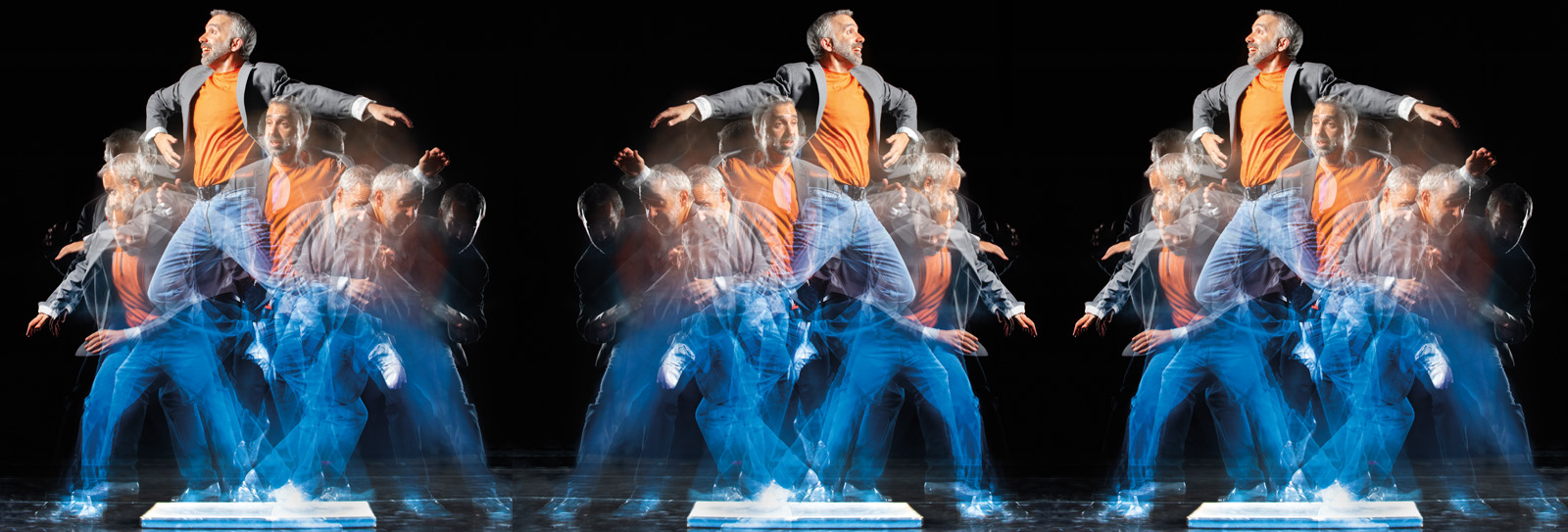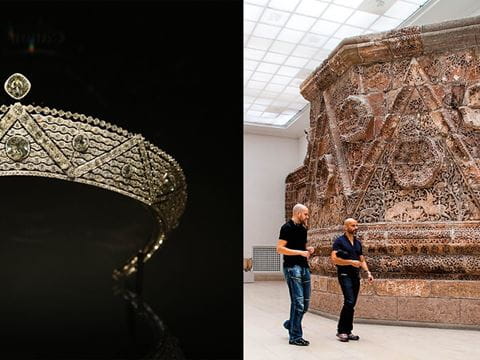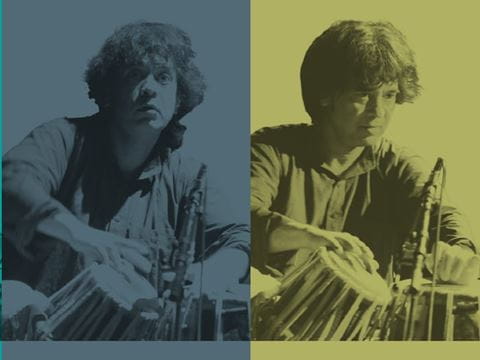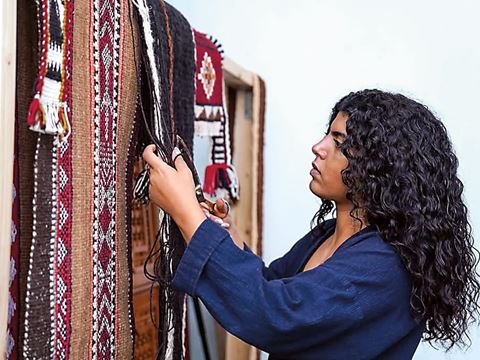
Andrew Nemr's Storytelling Through Tap Dancing
Telling stories about life journeys may not be what most people think tap dancers do, but that is where Andrew Nemr taps his way into a deeper root of the art.
Sweat beads Andrew Nemr’s face as he glides and clacks, clacks and glides his tap shoes on the well-scuffed wooden dance squares of his portable performance stage. Sound reverberates from the metal tapping tips at the toe and heel of each shoe, interspersed with his syncopated thumps on the wood. But he’s also talking, telling a story. It’s 2017, and his one-man production, Rising to the Tap, combines tap dance and choreography with storytelling.
Five years later, Nemr is still performing Rising to the Tap. He has appeared on countless stages large and small, TV and YouTube. He has given more than half a dozen TED Talks. Alongside Nemr’s own life experiences, his show and script have continued to evolve.
Nemr’s childhood memories of the Lebanese Civil War consist of TV screens showing columns of black smoke, bombed-out apartment blocks and chaos in the streets of Beirut, all framed by family discussions of a Lebanon that was.


“Even though I didn’t have personal connections to some of these stories, the relationship to Lebanon was evident,” he says.
Nemr makes it clear Joseph and Marlene, Nemr’s mother, never framed their own lives in terms of the war that had forced their emigration. Nonetheless, “it does something to a kid when you turn on the TV in the ’80s and there are pictures of the place where your parents are from being bombed,” he says. “I could see that my parents were feeling the pain of the war.”
When he was 3 years old, the family moved to the United States, just outside Washington, D.C. Soon after arriving he enrolled in his first dance class. At age 9 Nemr recalls he “fell in love” with tap dance after watching the 1989 movie Tap, which starred Gregory Hines and Sammy Davis, Jr. Most compelling was the film’s “challenge dance” scene, which featured tap legends Bunny Briggs, Harold Nicholas, Steve Condos, Sandman Sims and Jimmy Slyde.
“They were so free, so expressive, so in tune with themselves and the tap,” says Nemr. “I wanted to be like them.”
Nemr would later be mentored by Gregory Hines, a Tony, Emmy and Screen Actors Guild Award winner and one of the most-celebrated American tap dancers of all time. Nemr studied under Hines in New York at Woodpecker’s Tap Center, honing what Hines called Nemr’s “rich and truly expressive” skills.
It was at Woodpecker’s that Nemr also met New York tap dancer, actor and renowned dance mentor Savion Glover and, later, joined Glover’s DC Crew before helping found Glover’s dance company. International performances followed in 2001 at the Cannes Film Festival and the following year at the Winter Olympics Arts Festival. He tapped on the hallowed stage of the Apollo Theater, in Harlem, where so many musical icons began their rise to stardom, from Ella Fitzgerald and the Supremes to James Brown, Sammy Davis, Jr. and Michael Jackson.

He danced alongside and studied under some of the world’s best tap dancers including Jimmy Slyde, Sandman Sims, Elvera Davis, James “Buster” Brown, Dianne Walker, Barbara Duffy and Henry LeTang. These dancers, he says, became his “gateway into the oral tradition of the craft. They mentored me not only so I could share their steps but also share who they were.”
That resonated with Nemr, for whom dance has always been about the collective and the wider story of traditions and peoples sidelined, put down by injustice or chased by conflict.

“His universal, unique expression through tap—his style—is able to cross boundaries in ways that other forms of storytelling maybe can’t.”
—Jim Dolle
Dancing, says Nemr, “is choreographed movement that exhibits technique and entertains, but it also displays shape and leaves traces. If it’s done well, it tells a story: something historical, something commonplace or something that is both and beyond at the same time.”
That puts him in a class by himself. Contemporary US artist Makoto Fujimura once described Nemr as “one of the greatest tap dancers of our time” and perhaps “even greater of an artist.”

Jazz tap historian Constance Valis Hill wrote in her 2010 book Tap Dancing America: A Cultural History that Nemr is “one of the most hardworking and diverse dancers of his generation.”
As a TED Fellow, Nemr has explored how digital technology can help oral traditions survive and even thrive in changing times. In a talk entitled “Stepping Back in Time Before It’s Too Late,” Nemr related how his emergence into the tap-dancing scene in the US enabled him to become a carrier of its oral tradition, a raconteur of its “good ol’ days” and a chronicler of its 1990s reemergence into the national psyche.
“In all the change that goes on, there must be something that isn’t changing as fast,” he says. “For me, that something is, for lack of a better word, the nature of the person.”

courtesy andrew nemr / tap on barcelona / basilio gonzález
At the 2019 international event Tap on Barcelona, Nemr put on a workshop and performed.
When he speaks about oral traditions in workshops or courses, Nemr says, he likes to remind his students that until recently, each generation did not have its own styles of music. Music was shared through the years, passed down through generations: Music was communal. The purpose of music and dance was to reinforce the identity of the individual within the story of the community. In a world where every person can curate a unique soundtrack, that communal aspect of music and dance is vulnerable to loss, he says.
“In ‘tap-dance land,’ you learn this thing that you do from people, shaped in part by who they are and their personalities. And as you learn from them, you begin to embody someone else’s personality, someone else’s story—their choices, preferences, approaches to excellence, relationship to the audience, music—and then you can begin adding your own and passing it on,” he says.
It is, as he often tells his students, in these larger stories that one can really find oneself and, perhaps, make the world a better place.
“That pursuit has been a theme, a constant inquiry for me,” he says.

courtesy windrider institute
A screen shot from the film Identity: The Andrew Nemr Story shows Nemr performing on the streets of Tokyo. The documentary film unpacks the complexities of Nemr’s life-journey with tap dancing.

In 2004 Nemr founded his own dance company, Cats Paying Dues. It went on to garner critical acclaim with its focus on the ensemble rather than the individual. It also eventually brought Nemr into contact with Jim Dolle, branch director at McBurney YMCA in Brooklyn, New York, who in 2016 attended Manhattan Center’s Hammerstein Ballroom to catch a dancer Dolle had heard of but not yet seen perform in person: Andrew Nemr. As Dolle watched Nemr’s mix of tap and spoken word, a vision began to form in Dolle’s mind.
“I saw Andrew as an authentic catalyst for being able to build bridges between different communities in New York City—performers, artists and people of faith,” Dolle says.
Dolle met with Nemr after the show and warmed quickly to Nemr’s sincerity and kindness. Nemr became a regular instructor, coach and performer at the YMCA.
“Andrew’s power comes from his ability to cross genres and to connect with people of various backgrounds, to relate different cultures together, where you would not necessarily think there is a natural similarity,” Dolle says. “His universal, unique expression through tap—his style—is able to cross boundaries in ways that other forms of storytelling maybe can’t.”
Dolle also says Nemr “brings an interesting mix of heritage and personal experience that shows how circumstances in life are not that simple.”
Nemr describes some of his stories as not just narratives but homilies, intentionally instructive tales that invite the audience into both wider wonder and compassionate understanding.

“The stories that we tell can either breathe life into someone, or death. As a storyteller, there’s a lot of power there. And with a lot of power comes a lot of responsibility.”
That, he adds, requires a firm foundation, a grounding. For himself, that means always landing in the same place: on love.
“Over the course of my life, I experienced significant disappointment and pain, as relationships fell apart on account of things I had no control over. Other peoples’ lives are the same. The question is whether you allow a seed of bitterness to be planted and grow … or try to water the seed of love that is there even in the midst of that pain.”
That, he adds, is “the kind of story the world needs to hear more.”
About the Author

Bear Gutierrez
Bear Gutierrez is a Pulitzer Prize-winning photojournalist and commercial photographer based in Denver. After 10 years on staff at the Rocky Mountain News, he is now also a frequent volunteer mentor for aspiring journalists.
Ken Chitwood
Ken Chitwood, Ph.D., is an award-winning writer on religion, travel and culture. He is currently a Fritz Thyssen Foundation Postdoctoral Re- search Fellow at the Berlin Graduate School Muslim Cultures and Societies of Freie Universität Berlin. He is also a journalist-fellow with the University of Southern California’s Center for Religion and Civic Culture’s Spiritual Exemplars Project, and he lectures in Islamic science at Otto Friedrich Universität Bamberg.
You may also be interested in...

Cartier and Islamic Design’s Enduring Influence
Arts
For generations Cartier looked to the patterns, colors and shapes of the Islamic world to create striking jewelry.
Zakir Hussain Played Tabla in Indian Classical Music and Beyond
Arts
While mastery of Indian musical traditions is one clear accomplishment, the late Zakir Hussain’s bold pursuit of his art across genres likely best defines his legacy.
Al Sadu Textile Tradition Weaves Stories of Culture and Identity
Arts
Across the Arabian Gulf, the traditional weaving craft records social heritage.